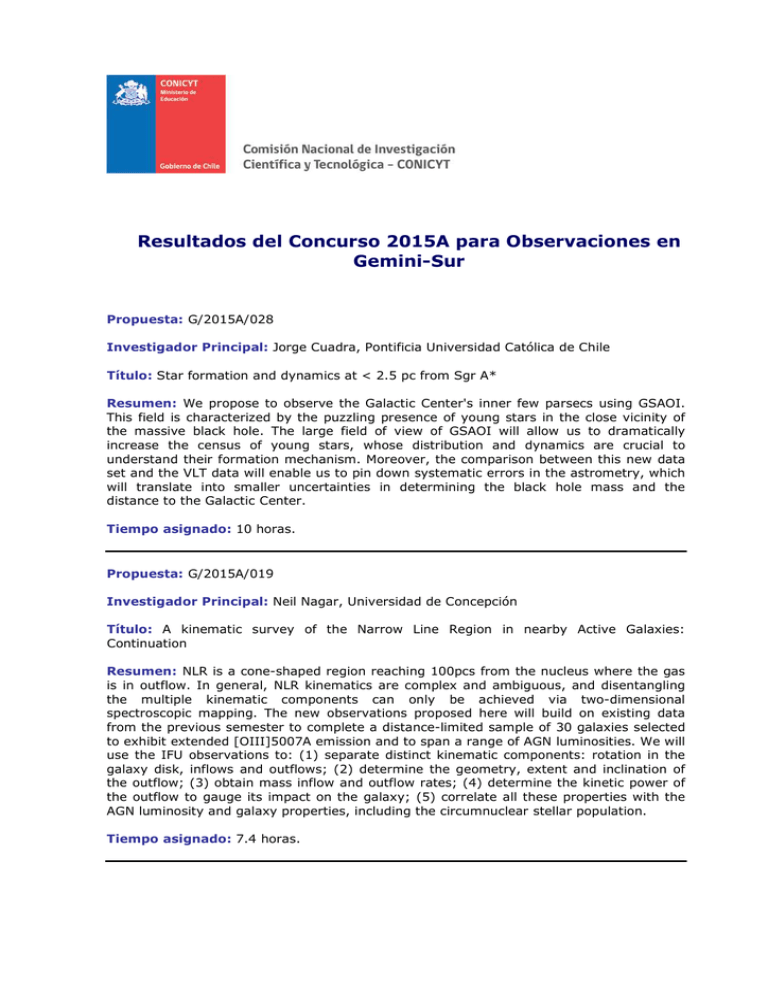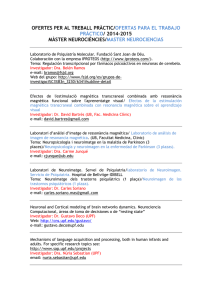Resultados del Concurso 2015A PAGINA WEB
Anuncio

Resultados del Concurso 2015A para Observaciones en Gemini-Sur Propuesta: G/2015A/028 Investigador Principal: Jorge Cuadra, Pontificia Universidad Católica de Chile Título: Star formation and dynamics at < 2.5 pc from Sgr A* Resumen: We propose to observe the Galactic Center's inner few parsecs using GSAOI. This field is characterized by the puzzling presence of young stars in the close vicinity of the massive black hole. The large field of view of GSAOI will allow us to dramatically increase the census of young stars, whose distribution and dynamics are crucial to understand their formation mechanism. Moreover, the comparison between this new data set and the VLT data will enable us to pin down systematic errors in the astrometry, which will translate into smaller uncertainties in determining the black hole mass and the distance to the Galactic Center. Tiempo asignado: 10 horas. Propuesta: G/2015A/019 Investigador Principal: Neil Nagar, Universidad de Concepción Título: A kinematic survey of the Narrow Line Region in nearby Active Galaxies: Continuation Resumen: NLR is a cone-shaped region reaching 100pcs from the nucleus where the gas is in outflow. In general, NLR kinematics are complex and ambiguous, and disentangling the multiple kinematic components can only be achieved via two-dimensional spectroscopic mapping. The new observations proposed here will build on existing data from the previous semester to complete a distance-limited sample of 30 galaxies selected to exhibit extended [OIII]5007A emission and to span a range of AGN luminosities. We will use the IFU observations to: (1) separate distinct kinematic components: rotation in the galaxy disk, inflows and outflows; (2) determine the geometry, extent and inclination of the outflow; (3) obtain mass inflow and outflow rates; (4) determine the kinetic power of the outflow to gauge its impact on the galaxy; (5) correlate all these properties with the AGN luminosity and galaxy properties, including the circumnuclear stellar population. Tiempo asignado: 7.4 horas. Propuesta: G/2015A/042 Investigador Principal: Patricio Rojo, Universidad de Chile Título: Investigating seasonal changes in Titan's meteorology through cloud monitoring with GPI Resumen: The presence of condensable volatiles and a thick atmosphere make Titan unique among known extraterrestrial environments, providing a natural laboratory in which to study a hydrologic cycle on a body other than Earth. We propose to study this hydrologic system by monitoring its cloud systems with GPI as soon as they are detected through a concurrent monitoring campaign using RToO triggers. The combined analysis of morphology (as resolved by adaptive optics) and cloud top altitude variation (as diagnosed by spectra) will constrain climate system models, diagnose cloud formation mechanisms, and supply context for interpreting surface features observed by Cassini. Using our own pipeline we will determine cloud locations to within 15 degrees latitude and 5-10 km altitude. Tiempo asignado: 4 horas. Propuesta: G/2015A/009 Investigador Principal: Lucas Cieza: Universidad Diego Portales Título: The Planetary Systems of Young Massive Stars Resumen: We propose to use the Gemini Planet Imager with nonredundant mask interferometry (NRM) to study planet formation around 29 massive stars in the Upper Scorpius region of the 5-15 Myr old Scorpius- Centaurus OB association. Even though ScoCen is the nearest large population of young massive stars, at a distance of 150 pc, analogues of our own gas giants (5-20 AU) have projected separations of only ~40-150 mas and thus fall inside the inner working angle of the GPI coronagraph. The extremely young planets in this separation range should be quite bright (contrasts of ~1000:1 in Kband), but even so, traditional imaging cannot efficiently access this separation range. As our team has demonstrated with precursor science at Keck and the VLT, an advanced technique like NRM is needed to achieve the necessary sensitivity at these small separations. Indeed, GPI-NRM will reach a contrast (~8 magnitudes, 2000:1 at 5-sigma) sufficient to detect massive gas giants in Sco-Cen down to the diffraction limit (~40 mas), and even slightly below. Thus, GPI-NRM provides the only means of probing the same region of orbital space for more massive stars as will be probed for closer, lower mass stars with coronagraphic imaging. Through this unique approach, our survey will fill a major hole in our understanding of extrasolar planets by measuring the frequency of planetary companions around 2--5 Msun stars, determining the primordial state of planetary systems, and when combined with other surveys, testing interior and evolution models of giant planets. Tiempo asignado: 2 horas. Propuesta: G/2015A/027 Investigador Principal: Paulina Lira, Universidad de Chile Título: Reverberation Mapping of high-z QSOs: the final stages Resumen: Reverberation mapping provides the only tool for obtaining the Black Holes (BH) mass in Active Galaxies. So far this method has been successfully applied only to low and intermediate luminosity systems (&lt; 10^46 ergs/s). We are extending these studies by two orders of magnitude, probing the BLR size (and BH-mass) of luminous AGN at redshift ~2-3, the peak of the Quasar era. Such large, slowly varying systems require a monitoring strategy that will maximise the likelihood of detecting significant variability. Since 2006 we have been monitoring a few docen very luminous Quasars using broad band imaging with the SMARTS consortium. Targets with significant variations have been followed up with the du Pont telescope covering Ly_alpha, SiIV, CIV and CIII. Now we have identified a handfull of sources with significant structure in their continuum and line curves which are very promising to deliver BH mass determinations in the next few years of monitoring. With this Gemini/F2 campaign we want to add the crucial low-ionization MgII line observed at ~10,000-10,600 A, and in some cases Hbeta at ~17500 A, to our monitoring campaign using the long slit capability of F2. Given the brightness of our sources, this would a very economic proposal with a high scientific return. Tiempo asignado: 1.5 horas. Propuesta: G/2015A/015 Investigador Principal: Tom Richtler, Universidad de Concepción Título: Is there dark matter in NGC 3962? Resumen: The nature of dark matter is one of the deepest mysteries in modern astrophysics. Alternative concepts like Modified Newtonian Dynamics have their successess in modelling disk rotation curves and explaining the tight baryonic Tully-Fisher relation. Isolated elliptical galaxies, not being exposed to external fields and often late mergers, are key objects in that respect. Cosmological simulations predict massive dark halos, but recent work on some isolated ellipticals failed to detect them. Here we propose to investigate the isolated elliptical NGC3962. Tiempo asignado: 12 horas. Propuesta: G/2015A/013 Investigador Principal: Cristina Garcia-Vergara, Pontificia Universidad Católica de Chile Título: The First QSO-LAE Cross Correlation Function Measurement at z ~ 4. Resumen: In the standard picture of structure formation, the first massive galaxies form in the highest peaks of the density field, which are the cores of massive protoclusters. Such structures must be exceedingly rare, and thus hard to find. Luminous QSOs at z ~ 4 are the most strongly clustered population in the Universe, and this large auto-correlation demands that they reside in massive DM halos, associated with large overdensities of galaxies. Thus the generic prediction is a strong QSO-galaxy cross-correlation for luminous QSOs at z ~ 4. We propose to use GMOS to obtain narrow-band images of 4 z~ 4 QSOs to identify surrounding Ly alpha emitters. This study will allow us to a) do the first QSO-LAE cross correlation function measurement at z ~ 4 b) study the impact of AGN feedback in their environs c) constrain the minimum mass of halos hosting QSOs at z ~ 4 and d) probe the extreme limits of the hierarchical buildup of structure over the first ~ 10% of the cosmic time. Tiempo asignado: 7.5 horas. Propuesta: G/2015A/031 Investigador Principal: Claus Tappert, Universidad de Valparaíso Título: Recovery of old novae Resumen: Nova eruptions are thermonuclear runaways on the surface of the white dwarf in a cataclysmic variable (CV). A few decades after the nova eruption, the characteristics of the underlying CV become dominant. Population studies of post-novae would therefore provide observational information on the importance of certain properties (magnetic field, mass-transfer rate, etc.) for the CV to undergo a nova eruption, as well as the impact of the eruption on those parameters. However, such research is severely limited by our incomplete knowledge of post-novae and their properties. The main reason is that still a large part of the Galactic novae lack identification of the post-nova system. We here propose to continue our program on unveiling the post-nova population by confirming selected candidates by the means of longslit spectroscopy. Tiempo asignado: 20.4 horas. Propuesta: G/2015A/001 Investigador Principal: Mariusz Gromadzki, Universidad de Valparaíso Título: Characterizing new late-T and Y dwarfs at the faint limits of WISE Resumen: We have identified candidate 350 - 650 K late-T and Y brown dwarfs at the faint limits of the WISE survey, using WISE multiple measurements and photometric profile fits to identify non-variable point sources detected only at 4.6 um (W2). Gemini North and South time in 13B and 14A was used to follow up 78 of these candidates with near-infrared photometry and spectroscopy. To date, we have spectroscopically confirmed five new T8-9 dwarfs and one new Y0 dwarf. We propose in 15A to essentially complete the follow up, by obtaining additional near-infrared data for 24 of the targets observed at Gemini, which are likely to be very cool brown dwarfs. Only 21 Y dwarfs are currently known. Increasing this number is important for sampling the wide range in cloud properties, surface gravity and chemical composition that is likely to exist, and which is suggested by the current dataset, in order to improve models. A census of such objects constrains the substellar mass function, the low-mass cut-off for star formation, and the Galactic star-formation rate. This work enables the WISE mission to reach its full potential for one of its key goals: discovery of the nearest and coolest brown dwarfs. Tiempo asignado: 20 horas. Propuesta: G/2015A/020 Investigador Principal: Thomas Puzia, Pontificia Universidad Católica de Chile Título: The Dynamical Properties and Velocity Function of Virgo Cluster Galaxies Resumen: We propose to construct the most complete circular velocity function (VF) and stellar-to-halo mass relation (SHMR), as two of the most direct though challenging tests of structure formation models, for Virgo early-type galaxies (ETGs) in the stellar mass range M* = 10^(8-9) Msol. We probe dynamics out to large radii (1-4 Re) in the important and largely unexplored transition regime of baryon-to-dark matter domination. We wish to complete our sampling of the VF/SHMR, characterise the emerging manifold of extended dynamical properties in ETGs and their link with structure formation models. This proposal is part of a large effort to model the dynamical and stellar population properties of a representative sample of Virgo ETGs for which deep UV/optical/NIR imaging exists. The proposed sample will significantly augment the crucial low-mass range below M* < 10^9 Msol, where the sharp LCDM predictions for the VF and SHMR are fully unconstrained due to significant incompleteness (0-30%) of current data bases. Numerous tantalizing trends, such as bifurcations and bimodalities, and/or possible discretization of the mass sequences below M* < 10^9 Msol for ETGs and LTGs, may prove transformational for galaxy structure studies and demand confirmation. We seek deep GMOS absorption spectra of 15 faint ETGs and 9 previously centrally (<1 Re) mapped ETGS, for a total of 60 hours of Canadian, US, and Chilean Gemini time. Our program exploits synergies of the Gemini and VLT observatories and will deliver a benchmark dataset of lasting legacy value, building upon our large Virgo cluster team expertise. Tiempo asignado: 20 horas.

